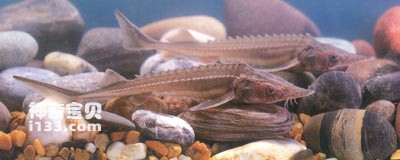Acipenser schrenckii (Acipenser schrenckii) belongs to the order Acipenser, family Acipenseridae, and genus Acipenser. Commonly known as: Seven Floats. English name: Amur sturgeon.
Endangerment level: Vulnerable.
IUCN (1996) EN CITES (1997) Appendix II.

The body is long and fusiform, with a tapered head and tail. The head is triangular in shape with a flat top. The muzzle is pointed and flat. The mouth is small, inferior, with transverse clefts, and the lips have petal-like wrinkles. There are 2 pairs of horizontal barbels in front of the mouth on the ventral surface of the snout, which are equal in length. There are several wart-like protrusions in front of the base of the barbels, most of which are 7, so they are called seven-grained floats. The body is covered with 5 longitudinal rows of bony plate-like hard scales, each with sharp spines, and the skin between the scales is rough. The dorsal fin is positioned posteriorly; the pectoral fin is positioned near the ventral surface, and the first unbranched fin is long and slightly stiff; the anal fin is located behind the base of the dorsal fin; the caudal fin is crooked. The head and back are grey-brown or dark brown, and the ventral surface is white.
Acipenser Schrenckii is a typical river fish that does not migrate long distances. They are lower-middle-level fish and are active almost all the time. Most of the ones seen in daily life are single individuals and rarely gather in groups. It usually inhabits the center of rivers, river covers and whirlpools of large rivers. It prefers waters with transparent water and rocks and gravel as the bottom. It usually moves slowly and likes to swim close to the bottom of the river, rarely entering shallow water areas and lakes; but it swims very actively when the water in the river rises in spring and there are strong winds and waves. They overwinter in the depths of rivers and swim to spawning sites when they thaw. Sexually mature individuals are generally over 1 meter long, weigh 6 kilograms, and are over 9 years old; females are slightly later. The spawning period lasts from the end of May to mid-July. It lays eggs in the main stream of rivers and gravel substrate environment. The water temperature is 17°C and the number of eggs carried is 510,000-2.8 million. The eggs are sticky. The feeding habits of sturgeons vary according to the age of the fish. Young individuals mainly feed on benthic invertebrates and aquatic insect larvae. In addition to feeding on benthic animals, adults also eat small fish and even water frogs. Sexually mature individuals have very low food intensity during the spawning period and may even stop eating.
Sturgeons are distributed in the Heilongjiang Basin, from the upper reaches of the Heilongjiang River to the Heilongjiang estuary in Russia.
The individual sturgeon is not as large as the catfish. The average length of 136 fish measured in 1979 was 1.54 meters, and the average weight was 22.5 kilograms. The largest individual was 2.44 meters long. Its lifespan is relatively long. A sturgeon that was 2.3 meters long and weighed 102 kilograms was once measured to be about 45 years old. Sturgeon is a large and valuable economic fish with high nutritional value. In addition to being eaten fresh, it can be smoked to make it taste better. Its ovaries are also the raw material for processed fish roe. Shark fins can be made into shark fins. The swim bladder and notochord are both raw materials for isinglass. The swim bladder has the same medicinal effect as the swim bladder of the catfish.
Since this species is a long-lived large fish with a late sexual maturity, the minimum age of female maturity is 15 years. Catches have been declining since the 1930s due to overfishing and other factors. It is currently on the verge of becoming endangered.
Russia has conducted research on the domestication and breeding of this species, and after success, it was promoted as one of the breeding targets in lakes and reservoirs. Since the 1960s, my country has carried out artificial breeding experiments and achieved success, and has accumulated rich experience in raising young sturgeons during the breeding process. Artificial hybridization experiments of sturgeons and catfish are currently being carried out to cultivate a generation of hybrids.
animal tags:
We created this article in conjunction with AI technology, then made sure it was fact-checked and edited by a Animals Top editor.